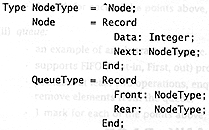| 5. | (a) Identify and explain the difference between a stack and queue abstract data-type. | [2] | ||
| A stack is a last-in first out data structure, | [1] | |||
| whereas a queue is a first in first out | [1] | |||
| [2 marks] | ||||
| (b) Given the following type definition for a queue: | ||||
|
||||
| Where Front points to the first element in the queue and Rear points to the last element added to the queue. It is assumed that the Next field of a Node points from newer elements in the queue to older ones. | ||||
| (i) Write a function sizeQueue that takes a queue of type QueueType as its argument, and returns an integer that identifies the number of elements in the queue. | [5] | |||
| A definition of sizeQueue follows: | ||||
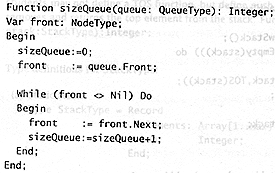 |
||||
| one mark for a correct function definition. | ||||
| one mark for creating a temporary variable of type NodeType, and assigning it to queue.Front. | ||||
| one mark for iterating down the queue, until the end of the queue is found. | ||||
| one mark for incrementing a size counter whilst walking down the queue. | ||||
| one mark for correct program structure (semicolons and grouping) | ||||
| do not deduct marks for trivial syntactic errors when marking the above points. | ||||
| [5 marks] | ||||
| (ii) Write a procedure enQueue that takes two arguments: (i) a queue of type QueueType; and (ii) an integer to be added to the queue. The effect of the procedure is to alter the queue argument by adding the integer parameter to the queue. | [6] | |||
| A definition of enQueue follows: | ||||
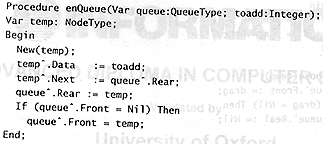 |
||||
| one mark for a correct function definition. | ||||
| one mark for allocating a new node type with New. | ||||
| one mark for assigning todata to Data field of the new node type. | ||||
| one mark for assigning the old rear of the queue to the Next field of the new node type. | ||||
| one mark for updating the Rear field of queue to the new node type. | ||||
| one mark for checking if the original queue was empty, so that a reference from the front of the queue to the new node can be made. | ||||
| do not deduct marks for trivial syntactic errors when marking the above points. | ||||
| [6 marks] | ||||
| (iii) Write a procedure deQueue that takes a non-empty queue of type QueueType as its argument. The effect of the procedure is to alter the queue by removing an element. | [7] | |||
| A definition of deQueue follows: | ||||
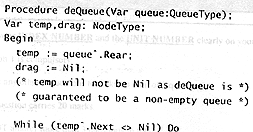 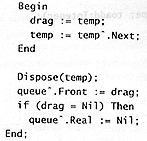 |
||||
| one mark for a correct procedure definition. | ||||
| one mark for defining a temporary variable of type Nodetype, and assigning it to the element at the front of the queue. | ||||
| one mark for iterating down the queue until the front of the queue is found. | ||||
| two marks for ensuring that after iterating down to the front of the queue, that a handle to the second oldest element in the queue is recorded. | ||||
| one mark for assigning the second oldest element in the queue to the field that represents the front of the queue. | ||||
| one mark for assigning the Rear field of the queue to Nil if there was only one element in the queue originally. | ||||
| do not deduct marks for trivial syntactic errors when marking the above points. | ||||
| [7 marks] | ||||
